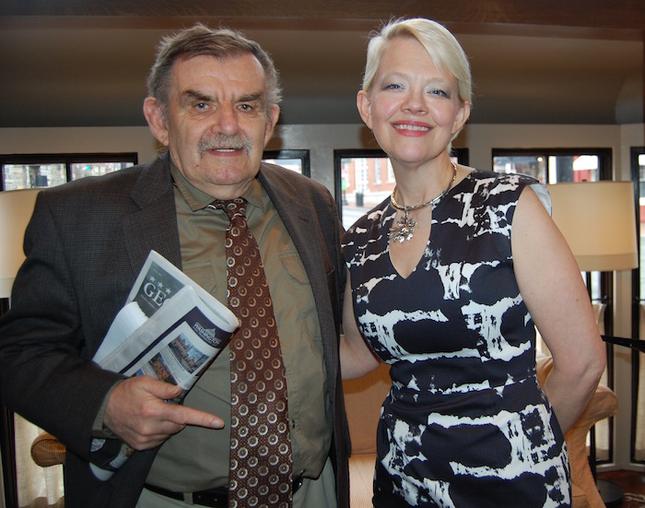National Portrait Gallery’s Kim Sajet Delights at the George Town Club
By • April 21, 2015 0 1738

Kim Sajet is shy.
All right, she’s not shy. Not at all.
The new (relatively, since 2013) director of what was frequently referred to as the venerable National Portrait Gallery looks, moves, talks and thinks as if she’s been freshly minted, in the moment, and looking ahead and not too much behind. She demonstrated these qualities vividly as the guest speaker at the Georgetown Media Group’s Cultural Leadership Breakfast at the George Town Club April 9.
Sajet, a striking blonde presence, is not the type to stand statically behind a podium (if there had been a podium). Personable and direct, funny with a self-deprecating sense of humor, Sajet proved to be rangy in both the way she managed to get to the heart of portraiture as art (and a pioneering art form of immediacy), and her role as chief embracer and explainer of an institution which, she said, she was surprised to be asked to head. She’s a gifted, natural storyteller, an emphasizer, a pacer and an embracer of the world of now and the next day.
Nothing stodgy here. Born in Nigeria to Dutch parents, raised in Australia, a mother (two young sons, ages 20 and 17 ), Sajet is bound to be an adept multi-tasker. Her credentials are diverse and impeccable—president and CEO of the Historical Society of Pennsylvania from 2007 to 2013, former senior vice president and deputy director of the Pennsylvania Academy of the Fine Arts, curator and director of two Australian museums, a master’s degree in art history from Bryn Mawr College and one in business administration at Melbourne University Business School, arts leadership training at the Harvard Business School, the Getty and National Arts Strategies. That’s more than enough to give her resume arts gravitas and reason enough to get the job offer for heading the National Portrait Gallery. “Plus, I speak three languages, all of them with an accent.”
But wait, there’s more. She has a bottomless well of enthusiasm enriched by thoughtfulness, a love of challenge, a willingness to not only elicit and entertain new ideas, but to have a few herself.
The idea for an American portrait gallery came from the example set by the British who’ve had their own National Portrait Gallery since 1856.
“The British can be so annoying that way,” she quipped. “They have so many kings and queens and royals, it’s kind of irritating. But we do have Katy Perry with a tiara—and nothing befits a woman more than a tiara. But she’s here because of her accomplishments—how many millions of records?”
Sajat noted that the NPG, renovated and sparkling as part of the Reynolds Center with the Smithsonian American Art Museum downtown, is about accomplishment, about “people who have had an impact on history and our own lives.” “But,” she said, “it is a living thing, about living human beings, that’s what a portrait is. We are pursuing portraiture in real time, as well as the presidents, the first ladies (we are backfilling there), scientists, artists, athletes and so on.”
But to her it isn’t just about categories of achievement, but about human beings who made decisions in their lives on their way to becoming who they were.
“You look at people like Albert Einstein or Lance Armstrong, and they made decisions that led them to become who they are,” she said. “When you look at their portraits that’s what you think about .”
“We are different from other galleries and museums—we deal in persons and personalities as well as art. Art matters, but the person being portrayed matters, too.”
“We all come to art in different ways, and when we see portraits we see ourselves. I remember when I was thirteen , a young girl, and I saw an Edward Hopper painting, one of those diners, and there were sundry people in it. Young men, lost people, a lady of the night, and in the middle of all that was a clown, and he was so terribly sad, and I thought, immediately, that’s, me, that’s how I feel, exactly, it’s my life.”
And during the courses of that story, she gave a perfectly audacious and exaggerated physical portrait of her young adolescent self.
“To me it’s amazing what happens when people encounter portraits and how full of opportunity the process is,” she said. “It crosses generations—here’s a father telling a son all about Lucille Ball or George Carlin, or the teen talking about a contemporary singer.”
Technology, she says, draws people into museums and “that’s a good thing.” She adds, “People today have so many digital images at their fingertips, in the computer, the pads, the phones.”
She recognizes and talks with humor about the constant scrutiny the NPG is under, including on a recent portrait of President Bill Clinton which apparently has the shadowy presence of a blue dress recalling sex and scandal.
“You have no idea what it’s like to part of the Smithsonian Institution and what that means in terms of scrutiny, how much attention and feedback you get today as well. I check the social media all the time, how we’re seen or mentioned on Yelp,” she said.
She sees this sometimes maze-like place, with its holdings and collections, its videos and portraiture contests—“An Asian girl had done a portrait—because she noticed she was eating almost nothing but rice—a self-portrait made entirely out of rice”—as a kind of fun house full of ideas about how people see themselves, are seen by others, and remembered. And there’s room almost for everybody. “I’m interested in the concept of outsiders, of a different kind of categories, including more women, more minorities, we’re working now on an exhibition about members of today’s American military and the wars they haves fought,” Sajet explains.
The popular and very focused “One Life” series will include Dolores Huerta, who stood side-by-side with Caesar Chavez in his battles for migrant workers
She fairly bursts with ideas and stories. When you listen to her, the notion of the National Portrait Gallery as a somewhat stodgy record of triumphant lives of leading men begins to fade. “I noticed,” she said, “that the exhibition on Elvis Presley was our most popular.”
She talks about the academic rigor of the writing and labels that go with the portraits. She talks about possibilities—“We are a national institution, but we should also include the international.”
The world is clearly changing, and it appears the National Portrait Gallery isn’t so much adapting as pushing to the forefront.
And it’s Kim Sajet, chief ringmaster and pied piper, who’s leading the way, with an accent.
- Gary Tischler of the Georgetowner and the Downtowner newspapers and Kim Sajet of the Smithsonian’s National Portrait Gallery | Robert Devaney



